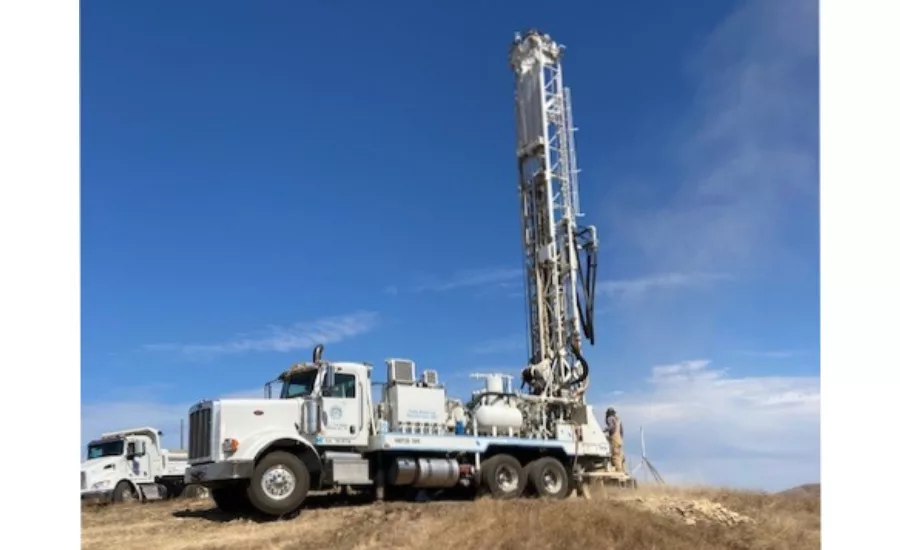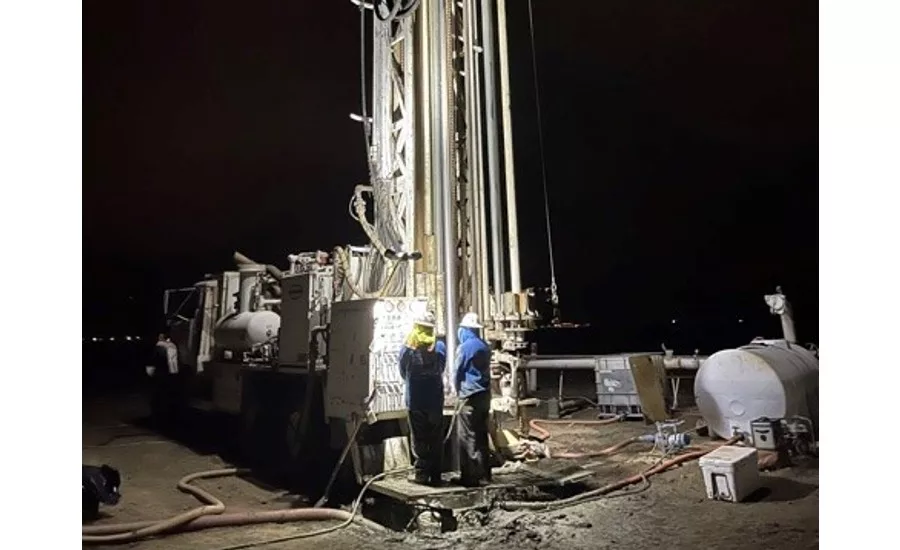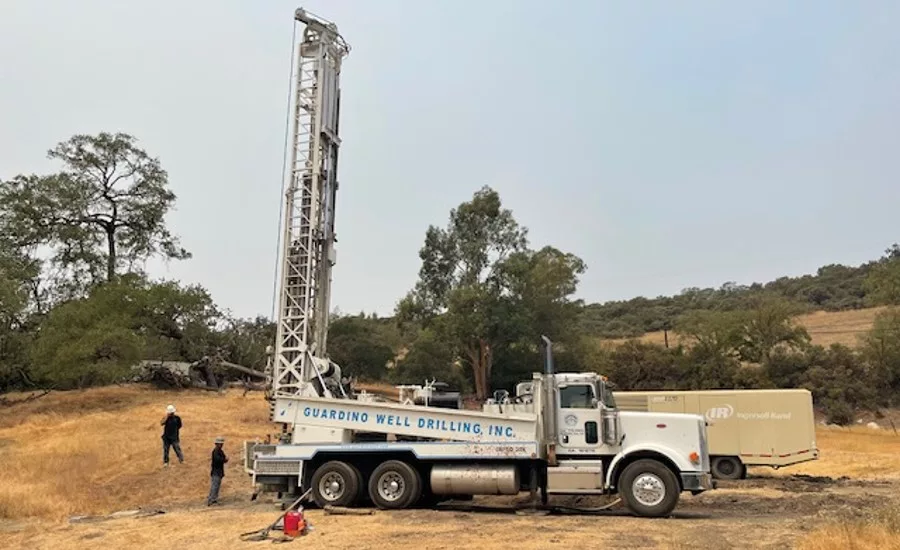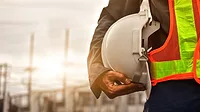A Driller’s On-the-Ground View of the California Drought
Demand, Low Rainfall Create ‘Perfect Storm’ for Drilling Businesses

Guardino Well Drilling Inc. drills a new 300-foot, 5-inch domestic well in Milpitas, California.
Source: Augie Guardino

A Guardino crew works around the clock to complete a 200-foot, 12-inch irrigation well in San Juan Bautista, California. The new well pumps at 900 gpm.
Source: Augie Guardino

Guardino Well Drilling sets up a Gefco 30K setting to drill an 840-foot air rotary test hole in Morgan Hill, California.
Source: Augie Guardino
Water well drillers dread hearing three words from customers: out of water. Yet, 2021 has seen persistent drought in large parts of Arizona, California, Idaho, Minnesota, Oregon and Utah, as well as more locally in other U.S. states. Drillers in these areas hear those words more and more often.
Severe drought can be bittersweet for drilling contractors. On one hand, it seems like a water emergency sits on the other end of every phone call. On the other hand, the high volume of customer calls keeps crews and equipment busy — and revenue rolling in.
To get a first-hand account of the business challenges and opportunities drillers face in drought-stricken areas, The Driller spoke with Augie Guardino of Guardino Well Drilling Inc. The company, based in Morgan Hill, California, about half an hour south of San Jose, does everything from small residential wells up to 16-inch irrigation wells across the Bay Area and California’s central region.
“Our bread and butter is the domestic air and mud rotary market that makes up about 50% of our business,” he says.
Guardino is the immediate past-president of the California Groundwater Association (CWA) and has also served on the board of the National Ground Water Association (NGWA).
Our conversation here is edited for clarity.
Q. How does the current drought compare to what you may have seen before and what does it look like in the areas you’re working in?
A. So, being a multi-generational company — I’m fourth generation; we’ve been around since 1929 — we always have the guidance of my dad. Fortunately, he’s still around. … He was drilling during what we always call the “last” drought in California, which was in the late 1970s. That’s when things weren’t really haywire. In terms of drilling, things weren’t really crazy.
Now, I worked through the last drought that ended a few years ago that, I believe, ran … 2013 through about 2018, which got a lot of nationwide publicity because of how it affected the agricultural drilling in the state of California. This [current] one is far worse, in terms of the drilling. Just to give you a backdrop of it, we call it a “perfect storm” because in our area, the Bay Area, where we typically receive over 20 inches of rainfall per year, we only received less than nine this year.
The wells in our area, the domestic wells, are drying up. They’re going dry. We also have development, landscaping, everything else which taxes the sources, that is affecting our area. On top of that, we have the snowpack in the Sierras, which has dwindled. So that’s affecting the farmers and that is affecting the residential market in different areas. ...
The last drought [in the 1970s] was more in terms of the farming. The farmers didn’t have the water from the snowpack, so a lot of large-diameter wells were drilled. This drought, yes, the snowpack was impacted, but different regions of the state have also not had a proper rainfall. So, you have all facets of it: the large irrigation wells and the domestic. It’s more of a perfect storm, whereas last time, it was the irrigation wells that everyone was after. This time, it’s everything. …
On top of that … where we live, when everyone was shut down from Covid, they were all working from home. They were all doing education from home. They were shopping from home. They were spending money from home. We live in the Silicon Valley, which produces everything that the rest of the world uses, in terms of the internet and everything, so our area was not, for the most part, adversely impacted economically from the Covid virus. What happened was ... [you had] the people staying at home, doing projects. So what I’m getting at is that there’s a lot more wells being drilled for irrigation, landscape — and so that’s impacted the market. We have a perfect storm.
Q. How has this affected your business and businesses like yours in California? Are you busier than you can ever dream, or are you kind of being pinched by both ends because the supply shortages? How would you characterize it?
A. There’s one more factor in there. Because of California and the Air Resources Board, and the mandates, we’ve had to update and upgrade our fleet and our drilling equipment [to comply with state emissions standards]. … Because of the Air Resources Board, and all this equipment that came due in the last couple years, we’ve had a lot of older companies shut down. So now, there’s fewer of us than there has been before.
With that said, the amount of work right now — and I want to be very careful how I say this, because it’s the busiest that we have ever seen it across the board in all facets of the industry, from every type of drilling to the pump installers — it’s at the point where potential consumers are getting frustrated and angry because there’s areas where folks like myself, we can’t even go out and take a look at potential job right now because we are so overwhelmed with everything going on, and there’s just no openings.
Q. So how far how far out are you scheduled?
A. We are scheduled out right now 38 projects.
Q. How does that affect equipment maintenance? How are you managing to keep things running as much as you can?
A. You still have your scheduled maintenance. But then the problem we have right now — that the rest of the world faces — is that, when we have minor wear and tear and mechanical issues or minor equipment issues, we can get shut down on a $350 part for our drill rig because it’s not in inventory anywhere in the country. You can never afford to skip maintenance. It’s just part of it. But we also use that as a the time, if we bring a rig in for an oil change and filter change, that kind of thing, we use that as a time for, “Okay, this crew gets a few 8-hour days instead of 12-hour days.” Then we use that time to take care of other things like cleaning up shop or reconnoitering.
Q. I’ve seen recent stories about drought in Minnesota, parts of Washington state and elsewhere. What are your recommendations for other contractors trying to manage their business through a period like this?
A. For us, we are trying to … accommodate for delays within our schedule. We’re trying to give ourselves a little bit of breathing room in terms of scheduling, so that we are not just going from job to job to job. We are making sure that we have enough staff to close out a job before we start a next one. … We’re trying to prevent chaos. A lot of times, what happens is, the phone starts ringing and people start emailing, calling: “You were supposed to be here. You’re supposed to be here.” Then we start moving forward without finishing up the last one. So, for us, we always try to leave enough room in our schedule for problems, whether it’s mechanical, whether it’s personnel.
We’re trying to give ourselves a little bit of breathing room in terms of scheduling, so that we are not just going from job to job to job. We are making sure that we have enough staff to close out a job before we start a next one.
The other thing is — we are constantly struggling with it, but it’s communication. What we find a lot of times with our customer base is, if we can just communicate with them what’s going on in terms of, “Here, this is where you are in our schedule and you will be next.” We’ve even gone as far as we’ve invited customers out on jobsites so that they can see what we’re up against. What we found is, it’s hard for people to fathom why you’re having breakdowns or why you’re delayed. If they come out to a jobsite and they watch us drill for another client, they can see the hows and whys of the machinery and what might cause delays.
That just comes back with that communication, but I don’t have a good answer for that because I wake up every day at 4 o’clock in the morning because my brain’s already thinking about the next week or two weeks ahead. I can tell you, to keep your sanity you still have to prioritize why you’re doing this. I mean, that’s our big thing. If you can’t go home at the end of the day and enjoy your own property or enjoy your own family, then what’s the point of it all? ...
In terms of advice, it’s just always try to stay one step ahead of it and anticipate. The problem that we have in our industry is that we’re always fearful because we’ve seen it. We’ve seen it end, so we know that, at any given point, it can all end. That’s the hard part too. That’s why our company, we try not to book out too far because we want to leave room for a real, true emergency, or we want to leave room for error and we don’t want to be dependent on work that’s supposed to be there in a year and a half.
Q. Five years from now, are we having this same conversation? I mean, do you expect things to stay the same, improve or maybe get worse?
A. That’s a slippery slope. The reason I say this is because, in our area, we see it continually getting worse, because we live in an area where it’s very expensive to build a home. It’s very expensive to purchase property. So people tend to have more landscape and they’re using a lot of water out here. We don’t see that stopping. So, from that standpoint, we see the demand for the water continuing. There is a big chunk of the science community that is referencing the global warming, and that this trend is here to stay. With those things and, if that continues, then yes, I think this is probably the new normal.
See what's happening in the water well market
The other thing that’s interesting is, whenever you see drought mentioned from a news media standpoint out here, they’re starting to tag global warming to it. That’s a whole other set of headaches and conversations and arguments and beliefs. But, if you look at it from that perspective, this could be the new norm.
Looking for a reprint of this article?
From high-res PDFs to custom plaques, order your copy today!









